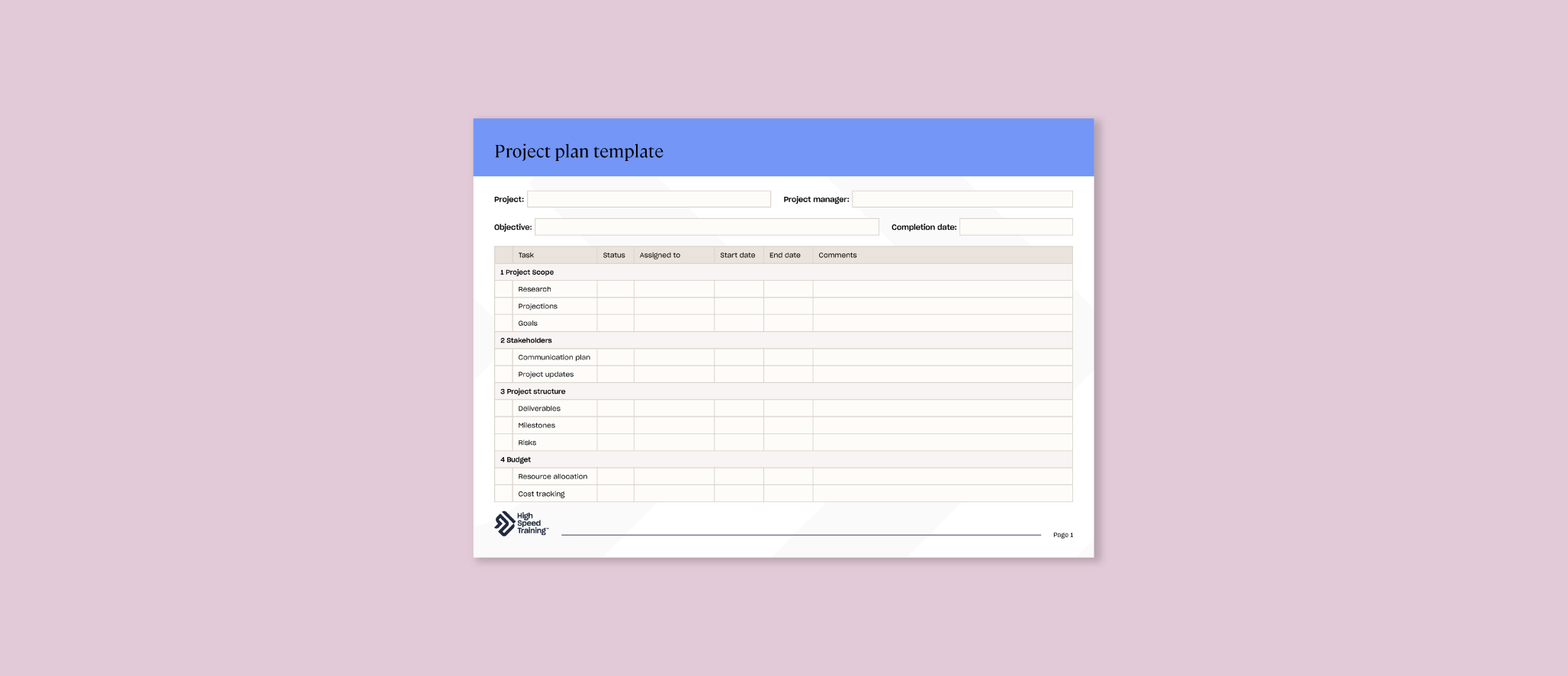Project Plan: Free Template
In order to run smoothly and successfully all projects require a level of careful planning and organisation. A project plan is an important part of curating a project and ensuring that set goals are achieved. In this article, we will outline what a project plan is and the process involved in efficiently creating one. We will also provide you with a free downloadable template that you can use when planning your next project.
What is a Project Plan?
A project plan is a plan of the specific goals, objectives and intended outcomes of a project. A project plan should include key information about the project’s scope, due date, deliverables and who is responsible for what. Project plans are typically used by project managers or managers/senior staff to ensure that the project runs smoothly and that the plan covers all necessary aspects. However, the process of creating a project plan is a useful skill for all employees to have as it can support an organised approach to all facets of work life.

Importance of a Project Plan
Project plans are important as they help you to keep track of what should be done, by whom and when. Project plans provide direction and guidance, helping to reduce confusion and frustration. A clear project plan provides an invaluable baseline all those involved can refer back to. This enables them to have the necessary information regarding what is expected of them, what they need to provide and what role others are playing. This ensures that everyone stays accountable and that people know who they need to turn to for additional support or input when necessary.
For project managers, a project plan is a vital document that supports the execution of the project. It provides managers with the chance to forecast potential challenges, ensure that the project is achievable and that tasks are allocated appropriately.
Want to Learn More?
High Speed Training has a wide range of Online Training Courses that can develop your project planning skills.
Project Planning Process
There are many different ways in which you can approach project planning. Nevertheless, most project plans follow a similar format that encompasses the core elements of a project and what needs to be achieved. In order to be as effective as possible a project plan should at the very least include the following components:
- Scope
- Budget
- Timeline
You can then add any additional information that you need to your individual plan.

A strong project plan guides the project and acts as a reference point for all those involved. To make your project plan efficient you can break the planning process down into five steps. These are:
- Define the project scope – Defining the project scope entails determining what the project will actually include. This step ensures that the project is in fact achievable and determines the goals and objectives necessary to ensure the success of the project. When completing this stage utilising the SMART method can be helpful as it ensures that all goals are clear and realistic.
- Communicate with stakeholders – Depending on the scope of the project you may need to include others in the business with a vested interest. Stakeholders tend to include those in more senior roles who may be in charge of staffing and budgeting, or those who requested the project in the first place. Identify who the relevant stakeholders are and begin communication with them in order to foster collaboration and transparency for all involved.
- Determine a structure – Once you have defined the scope of the project and communicated with the necessary people, you need to create a blueprint of the work necessary to complete the project. This includes determining deliverables, milestones and an allocation of resources. It can also be useful at this stage to look ahead for any potential pitfalls and what steps you can put in place from the beginning to help mitigate those risks.
- Set budget – The resources that are available to you will greatly determine how you approach the project. It’s therefore vital that you have an understanding of what resources are available. It’s important that you allocate your resources carefully to ensure that you have the means to deliver the intended goal.
- Formalise schedule and timeline – The final step is to collate all the planning that you have done and generate a schedule and timeline. It can be helpful to work backwards from your deadline to ensure that everything can be completed on time and if not what adjustments need to be made to make it viable. Effective time management is vital to a project running smoothly and so you must ensure that you take the time to carefully formalise and plan your schedule. There are numerous different time management techniques which you can adopt to support the project and your team to stay on schedule.
After completing a project plan you may decide to share it with internal stakeholders for final confirmation and sign off, or this may not be necessary for your specific project.
Project Plan Template
Below you will find a free project plan template that you can use when planning your next project. The template follows the steps listed above and can be used to create a blueprint for success. As with any template, it’s important that you tailor it to the needs of your project so that it is as effective as possible. There are many ways to present a project plan and it can be intimidating when staring at a blank page not knowing where to start. A template can therefore be a useful starting point, offering clear direction and guidance. However, it’s important that you make the necessary changes so that any template you use accurately pertains to your project.
Templates can come in various formats and the type of template you use may vary depending on the project. For example, if your project is more quantitative based and has set metrics that must be measured throughout, you may find that Excel or Google Sheets works best. Comparatively, for information heavy projects that require sharing a lot of detail, Word or Google Docs may be better suited. Each template and format will have its own pros and cons and so it’s important that you take the time to consider what works best for you, your team and your project.

Effective project planning can be the difference between a project succeeding or failing. Taking the time to consider what needs to be done, how it needs to be done, who needs to do it and when, ensures that your project stays on track and has a clear direction. Proper planning enables careful consideration, mitigation of risks and the appropriate allocation of resources thereby helping to ensure a project runs smoothly and successfully.
Further Resources:
- A Personal Development Plan (PDP) Guide & Template
- What is Critical Reflection?
- Business Essentials Courses







